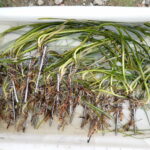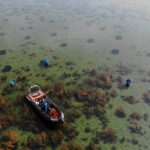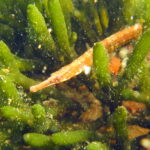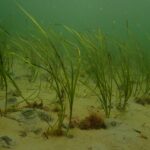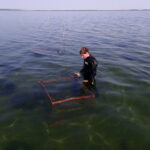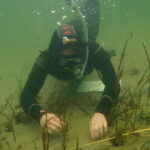Seagrass Restoration Grevelingen
It takes perseverance to restore subtidal seagrass—and not just because we have to dive. But in the Grevelingen, we have been pioneering seagrass restoration since 2017. Restoring seagrass in the Southern Delta requires a completely different approach than in the Wadden Sea. Here, seagrass grows mostly below the waterline rather than on exposed intertidal flats. Additionally, the unique history of the Southern Delta presents its own challenges for seagrass restoration.
Share this project
How Seagrass Disappeared from the Grevelingen
Before the Grevelingen Dam was built and the Brouwersdam was closed, the Grevelingen was an estuary where freshwater from rivers mixed with the North Sea. After the dam was built, the newly encolsed Lake Grevelingen became brackish and lost its tidal flow, eelgrass (Zostera marina) adapted to this altered environment by growing at greater depths and adopting a perennial strategy. As a result, its coverage at first expanded from 1,440 to 4,600 hectares.
However, this successful adaptation eventually turned into a disadvantage. When the Brouwers Lock was reopened and salinity increased again, the seagrass was no longer able to germinate—and it disappeared completely.
Today, water quality has improved, and Rijkswaterstaat has implemented more natural water management strategies, creating new opportunities for seagrass to return through restoration efforts.
Restoration Pilots
The first restoration pilots were based on lessons learned in the Wadden Sea, where seagrass restoration has been ongoing for a longer time. Seed-bearing donor plants were collected on Sylt (Germany). Some were placed in floating onion bags using the BuDs method to disperse seeds by letting them fall through the mesh bags, while others were stored in a bubble system to ripen before winter storage. In spring, thousands of those ripened seagrass seeds were injected into the sediment using caulking guns, a method that had already shown success in the Wadden Sea.
However, both methods failed in the Grevelingen. As a result, the focus shifted to transplanting donor plants from Hamburger Hallig (Germany) and Limfjord (Denmark)—a method that now shows promising results.
An Incomplete Food Web
Even with successful transplanting, restoration remains challenging.
- Marine worms (lugworms) churn up the seabed so intensely that they bury new seedlings. Attempts to exclude them using barriers and tea bags were unsuccessful.
- Crabs pose another threat—they eat seeds, trample young plants, and cut leaves. In the Grevelingen, crabs are three times more abundant than in natural seagrass meadows. Instead of keeping them out, exclosures attracted more crabs.
- Sand mason worms glue seagrass leaves together, while periwinkles, which naturally clean the seagrass, are too scarce to counteract this effect.
To address these issues, periwinkles are now being introduced alongside transplanted plants. For other challenges, no perfect solution has been found yet—except planting more seagrass. A dense, extensive seagrass meadow is naturally more resilient to external pressures.
Want to learn more about seagrass restoration? Check out the Wadden Sea Seagrass Restoration project or browse through our news page.
Client
Rijkswaterstaat
Involved part(ies)

NIOZ




